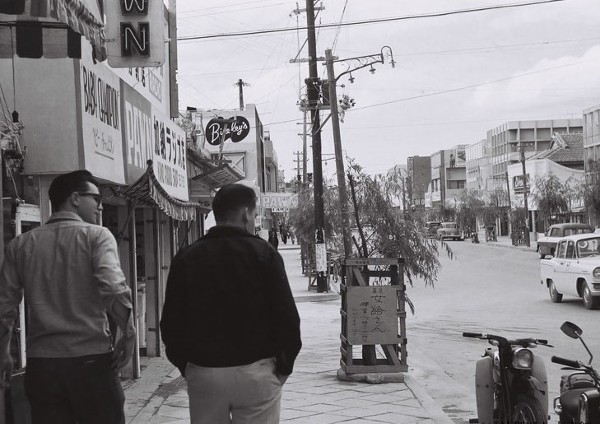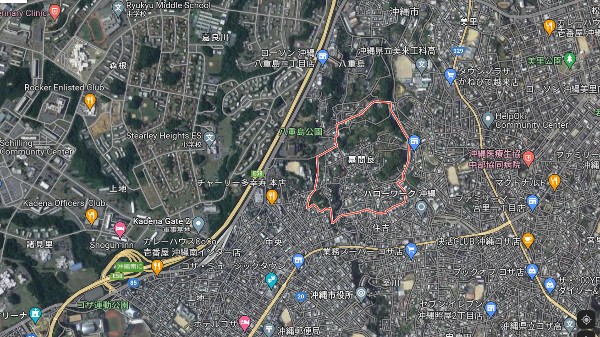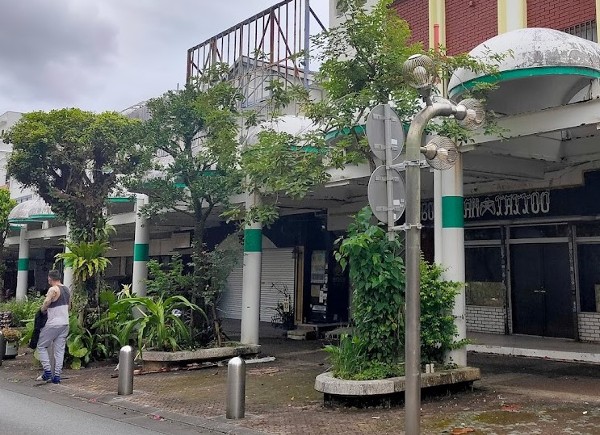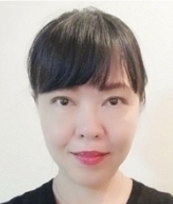[평화예술칼럼 Peace Art Column] (89) 토미야마 카즈미
제주도는 평화의 섬입니다. 항쟁과 학살의 역사를 가지고 있기에 평화를 염원하는 마음은 더욱 간절할 수 밖에 없습니다. 제주4.3이 그렇듯이 비극적 전쟁을 겪은 오키나와, 2.28 이래 40년간 독재체제를 겪어온 타이완도, 우산혁명으로 알려진 홍콩도 예술을 통해 평화를 갈구하는 ‘평화예술’이 역사와 함께 현실 속에 자리 잡고 있습니다. 이들 네 지역 예술가들이 연대해 평화예술운동을 벌이고 있습니다. 이들의 평화예술운동에 대한 창작과 비평, 이론과 실천의 공진화(共進化)도 매우 중요합니다. 독립언론 [제주의소리]가 네 나라 예술가들의 활동을 ‘평화예술칼럼(Peace Art Column)’을 통해 매주 소개합니다. 필자 국적에 따른 언어가 제각각 달라 영어 일어 중국어 번역 원고도 함께 게재합니다. [편집자 글]
행정 구획으로서의 오키나와현은 동서 약 1,000㎞, 남북 약 400㎞의 광대한 해역을 가지고 있으며, 거기에 160개의 섬들이 흩어져 있다. 그 중 사람이 살고 있는 곳은 47개, 무인도는 113개이다(2018년 현재). 가장 큰 섬인 오키나와 섬은 류큐 왕국 시대부터 정치와 경제의 중심이었으며, 현재도 오키나와 현의 총인구 약 145만명의 약 90%에 해당하는 129만명이 살고 있다.
오키나와 섬에 집중되어 있는 것은 인구만이 아니다. 1945년 오키나와전에서 일본군에 승리한 미군이 섬을 점령하고 군사기지 건설을 시작해 오키나와 섬 총면적 약 1204㎡의 15%가량이 현재까지도 미군 용지로 남아 있다. 전쟁 전까지 오키나와 인구의 70% 가까이가 농업 종사자였지만 전후에는 많은 오키나와인이 이 거대한 기지의 노동자로 변신할 수밖에 없었다. 게다가 기지 주변에서는 미군 관계자에게 서비스를 제공하는 다양한 장사가 시작되어 번화가가 형성되어 간다. 그 거리는 일자리를 찾아 다른 섬에서 나온 사람들(다른 섬은 더 가난했다), 특히 여자들을 포섭하고 성장하는 야행성 동물을 닮았다. 기지 거리에서 미군에게 술을 먹여 섹스의 상대가 됨으로써 자신뿐 아니라 가난한 가족에게 삶의 양식을 준 여자들의 수는 헤아릴 수 없다.

오키나와 소설가 요시다 스에코가 1980년대 오키나와를 무대로 쓴 1984년 발표작, <카마라 동반자살(嘉間良心中)>(1984)은 그런 여자들 중 한 명인 키요를 주인공으로 한다 '카마라'는 카데나 기지에 접해있는 최대의 특음가 뒤편의 구역 이름이고, '심중(心中)'이란 서로 사랑하는 남녀가 합의 하에 함께 죽는 것이다. 그러나 이 이야기의 전개와 결말에서 로맨틱한 요소는 거의 볼 수는 없다. 키요는 오키나와전 전에 태어나 전후 작은 섬을 나와 언젠가부터 기지 거리에서 창녀가 됐고 58세가 되도록 길거리에서 미군들을 유혹하고 있다. 하지만 그들은 늙은 창녀에 놀라 도망가 버리기 때문에, 키요의 삶은 곤궁하다. 동향인 남편과는 일찍 이혼해 30대가 된 딸들과도 접촉이 없어 손자가 있는지조차 알 수 없다. 키요는 고지대에 올라 태어난 섬을 조망할 때만 마음의 평안을 느낀다. 그런 키요의 일상이 미군기지에서 탈영한 18세 백인 소년병을 만나 자신의 아파트에 숨겼을 때부터 불온한 궤적을 그리기 시작한다.
새미(Sammy)라는 소년병은 상관을 말다툼 끝에 총검으로 찌르고 기지에서 도주했다. 새미는 우선 일본 본토로 건너가 북한이나 소련으로 탈출할 테니 고향의 어머니로부터 돈이 도착할 때까지 키요의 아파트에 있게 해달라고 부탁하고, 키요는 승낙한다. 이 위험한 탈영 방조의 대가로 키요가 얻는 것은 새미의 젊은 육체를 탐하는 기쁨이었다. 키요는 자신이 몸을 파는 생업이기에 이런 행복을 만날 수 있었다고 감사하기까지 한다. 아파트에 눌러앉은 새미에게 용돈을 달라고 졸라도 키요는 그걸 58세의, 아무도 상대해주지 않게 된 장사녀가 손자처럼 어린, 영화 속에서 빠져나온 듯한 미소년을 품은 대금이라고 생각했다.

그러나 그런 나날은 반년 만에 파국을 맞는다. 새미는 탈영 생활의 의외로 평범하고 지루한 일상에 질려 군대 생활과는 다른 새로운 지옥에 시달리기 시작했다. 몸을 맞대는 것조차 싫어하는 새미에게 키요는 자신이 그에게 끔찍한 존재가 되고 있음을 감지한다. 새미로부터 기지에 출두해 처분을 받겠다고 결심했다는 말을 들은 날, 키요는 프로판 가스 밸브를 열고 잠든 새미의 젊은이 곁으로 몸을 기댄 채 라이터를 점화한다. 그 순간에 이야기는 끝난다.
죽음을 함께한 남녀의 이야기이기에 작가는 그 작품에 '동반자살(心中)'이라는 제목을 부여했다. 그러나 남자는 정사에 합의 같은 건 하지 않았고 오히려 여자에게서 도망쳐 제자리로 돌아와 다시 살아나려던 것을 키요가 그 삶의 가능성을 폭력적으로 빼앗은 것이다. 그 폭력은 키요 자신의 삶을 희생하는 것이기는 했지만 폭력을 행사하는 주체가 ‘오키나와 여자’라는 점이 이 작품 세계를 특이하게 만들고 있다. 군사식민지라는 현실은 오키나와의 전후문학에 큰 영향을 당연히 가져왔지만, 그 속에서 그려져 온 ‘오키나와 여인’은 많은 경우 점령자인 남성의 폭력 객체이거나 피점령자 자신에게 위무를 주는 토착정신의 표상이었다. 그러나 이 이야기의 여성 작가는 여자가 제멋대로인 미국인들에게 버려져 비탄에 빠진다는 뻔한 결말을 택하지 않고 키요에게 말 그대로 목숨을 건 현실에 대한 레지스탕스를 행하게 한 것이다.


키요는 켜켜이 겹쳐있는 차별구조의 최하위에 있었다. 일본이라는 국가 안에서 마이너리티로서 차별받는 오키나와지만, 그 내부에조차 중심(오키나와 섬)에 의한 주연(낙도) 차별은 존재한다. 키요는 낙도 출신이고 여성이며 교육으로 인해 사회계층을 상승할 기회조차 없었다. 점령자를 상대하는 창녀로 사는 바람에 고향 섬과 가족도 손절했고 이제는 창녀로서의 가치마저 노추하게 잃고 있었다. 새미는 그런 그녀의 품에 뛰어든 방황하는 새였다. 미국의 백인 남성이면서도 점령자 집단에서 탈락해 정신적으로나 성적으로나 어리고 살아갈 돈도 없는 그저 아름답기만 한 약자. 무력함이라는 점에서 두 사람은 대등하지만 키요는 그를 성적으로 착취해 적은 돈으로 묶어둘 수 있었다. 점령자와 피점령자의 관계가 역전되어 사랑이란 없어도 타인을 ‘점령’할 수 있는 쾌감을 알게 된 키요는 자신의 왕국에서 나가려는 피점령자를 용서할 수 없었다.
키요는 새미에게 ‘함께 내 섬으로 도망가자, 저기라면 아무도 찾을 수 없어, 빈 집도 많다’고 외치지만, 그는 ‘됐어, 이제 끝났다’고 잘라 말한다. 미군기지에 더럽혀진 거리, 차별받는 거리를 버리고 태어난 섬으로 귀환한다는 몽상이 키요의 마음에 존재했음을 헤아려보면 너무나 안타깝다. 키요는 오키나와 직물로 만든 값비싼 기모노를 입고 죽음의 여행을 떠난다. 그 앞길은 그녀의 섬이고, 그 길동무는 그녀가 ‘점령’한 아름다운 젊은이다. 전쟁과 점령을 살았던 외로운 여성의 심상과 은밀한 욕망을 그린 이 작품은 ‘다크 콜로니얼 판타지’로 새롭게 읽힐 수 있는 요소들을 확실히 내포하고 있다.

# 토미야마 카즈미 토미야마 카즈미(豊見山和美 TOMIYAMA Kazumi) 씨는 도쿄 소재 추오대학교와 류큐대학교 대학원에서 법학을 전공했으며, 영국 런던대학교 아카이브연구 석사과정을 마쳤습니다. 이후 오키나와현립공문서관의 아키비스트로 일하면서, 오키나와 전후사를 중심으로 문화평론을 하고 있습니다. |
「占領」する女―吉田スエ子『嘉間良心中』を読む
豊見山和美
行政区画としての沖縄県は、東西約1,000km、南北約400kmの広大な海域を持ち、そこに160の島々が点在する。そのうち人が住んでいるのは47、 無人島は113である(2018年現在)。最大の島である沖縄島は、琉球王国時代から政治と経済の中心であり、現在も沖縄県の総人口約145万人のおよそ9割に当たる129万人が住む。
沖縄島に集中しているのは人口だけではない。1945年の沖縄戦で日本軍に勝利した米軍が島を占領して軍事基地建設を始め、沖縄島の総面積約1204㎡のおよそ15%が現在でも米軍用地のままだ。戦前まで沖縄の人口の7割近くが
農業従事者だったが、戦後は多くの沖縄人がこの巨大な基地の労働者に転身せざるを得なかった。さらに、基地周辺では、米軍関係者にサービスを提供するさまざまな商売が始まって、繁華街が形成されていく。その街は、仕事を求めて他の島から出てきた人々(他の島はもっともっと貧しかった)、とりわけ女たちを吞み込んで成長する、夜行性の動物に似ていた。基地の街で、米兵に酒を飲ませ、セックスの相手となることで、自分だけでなく貧しい家族に生活の糧を与えてきた女たちの数ははかり
知れない。
沖縄の小説家・吉田スエ子が1980年代の沖縄を舞台に書いた作品『嘉間良心中』は、そんな女たちの一人であるキヨを主人公とする(発表は1984年)。「嘉間良」とは嘉手納基地に接する最大の特飲街の裏手にある区域の名で、「心中」とは相愛の男女が合意の上で一緒に死ぬことだ。しかし、この物語の展開と結末にロマンティックな要素を見ることはほとんどできない。キヨは沖縄戦の前に生まれて、戦後、小さな島を出ていつからか基地の街で娼婦になり、58歳になっても路上で米兵を誘っている。だが彼らは老いた娼婦に驚いて逃げ出してしまうから、キヨの暮らしは困窮している。同郷の夫とは早くに離婚し、三十代になった娘たちとも接触はなく、孫のあるなしさえわからない。キヨは高台の城址にのぼって生まれた島を眺望する時だけ、心の安らぎを覚える。そんなキヨの日常が、米軍基地から脱走した18歳の白人少年兵に遭遇して自分のアパートに匿った時から不穏な軌跡を描き始める。
サミーという少年兵は上官を口論の挙句に銃剣で刺し、基地から逃走していた。サミーは、まず日本本土に渡って北朝鮮かソ連に脱出するから、故郷の母から金が届くまでキヨのアパートにいさせてほしいと頼み、キヨは承諾する。この危険な脱走幇助の対価としてキヨが得るのは、サミーの若い肉体をむさぼる歓びだった。キヨは、自分がからだを売る生業だからこそ、こんな幸福に巡り合えたと感謝さえする。アパートに居ついたサミーに小遣いをねだられても、キヨはそれを「58歳の、誰も相手にしてくれなくなった商売女が孫のように年下の、映画の中から抜け出てきたような美少年を抱く代金」だと考えていた。
しかしそんな日々は半年で破局を迎える。サミーは「脱走生活の意外に平凡で退屈な日常」に飽き、軍隊生活とは別の新たな地獄に苦しみ始めた。体を触れ合うことさえ嫌がるサミーに、キヨは自分が彼にとっておぞましい存在になっていることを感知する。サミーから基地に出頭し処分を受けると決意したと告げられた日、キヨはプロパンガスの栓を開放し、眠るサミーの若者の傍らに体を寄せ、ライターを点火する。その瞬間で物語は終わる。
死を共にした男女の物語であるがゆえに、作者はその作品に「心中」というタイトルを与えた。しかし男は情死に合意などしておらず、むしろ女から逃げ出して元の場所に戻り生き直そうとしていたのを、キヨがその生の可能性を暴力的に奪ったのだ。その暴力はキヨ自身の生をも犠牲にするものではあったが、暴力を行使する主体が<沖縄の女>であることが、この作品世界を特異なものにしている。軍事植民地という現実は、沖縄の戦後文学に大きな影響を当然にもたらしてきたが、その中で描かれてきた<沖縄の女>は多くの場合、占領者である男性の暴力の客体であるか、被占領者自身に慰撫を与える土着の精神の表象だった。しかしこの物語の女性作家は、女が身勝手なアメリカ人に捨てられて悲嘆にくれるというありきたりな結末を選ばず、キヨに文字通り命を懸けた現実へのレジスタンスを行わせたのだ。
キヨは、重層する差別構造の最底辺にいた。日本という国家のなかでマイノリティーとして差別される沖縄だが、その内部にさえ中心(沖縄島)による周縁(離島)差別は存在する。キヨは離島出身者であり、女性であり、教育によって社会階層を上昇する機会さえなかった。占領者を相手とする娼婦として生きるがゆえに、故郷の島からも家族からも孤絶し、いまや娼婦としての価値さえ老醜に失っていた。サミーは、そんな彼女の懐に飛び込んだ迷い鳥だった。アメリカの白人男性でありながら、占領者集団から脱落し、精神的にも性的にも幼く、生きていく金も持たない、ただ美しいだけの弱者。無力さという点で両者は対等だが、キヨは彼を性的に搾取し、わずかな金でつなぎとめることができた。占領者と被占領者の関係が逆転し、愛などなくても他者を<占領>できる快感を知ったキヨは、自分の王国から出ていこうとする被占領者を許すことが
できなかった。
キヨはサミーに、一緒に私の島へ逃げよう、あそこなら誰にも見つからない、空き家だってたくさんあると叫ぶが、彼はいいんだ、もう終わったんだと言い放つ。米軍基地に汚された街、差別される街を棄てて生まれ島へ帰還するという夢想がキヨの心に存在していたと知るのはあまりにも切ない。キヨは沖縄の織物でできた高価な着物を身につけて、死出の旅に向かう。その行く先は彼女の島であり、その道連れは彼女が<占領>した美しい若者だ。戦争と占領を生きた孤独な女性の心傷と密かな欲望を描いたこの作品は、ダーク・コロニアル・ファンタジーとして新たに読み返されるべきものを確かに内包している。
写真1 1960年代のコザ。米軍基地に隣接する繁華街を歩く非番の兵士。道端に「女給さん募集」の看板がある。
写真2 googlemapより。左半分は嘉手納基地、右半分は民間地域。赤い枠の中が嘉間良地区。Kadena Gate2近辺に繁華街が伸びる。
写真3 コザ、2022年撮影。タトゥー施術をして歩き出す米兵。かつて米兵で賑わった通りも、今は多くの店がシャッターを下ろしてさびれてしまった。
写真4 コザ、2022年撮影。かつて米兵の落とすドルで賑わっていたクラブの古い建物。今は若者向けの飲食店にアレンジされている。
The Woman as an 'Occupier' - YOSHIDA Sueko's novel “Love Suicide at Kamara”(Kamara Shinju)
TOMIYAMA Kazumi
Okinawa Prefecture as an administrative division has a vast sea area of approximately 1,000 km from east to west and 400 km from north to south, dotted with 160 islands. Of these, 47 are inhabited and 113 are uninhabited (as of 2018). The largest island, Okinawa Island, has been the political and economic centre of Okinawa since the days of the Ryukyu Kingdom and is still home to 1.29 million people, or approximately 90% of Okinawa Prefecture's total population of 1.45 million.
It is not only the population that is concentrated on Okinawa Island: after the victory over the Japanese in the Battle of Okinawa in 1945, the US military occupied the island and began building military bases, and to this day approximately 15% of the island's total area of about 1204㎡ remains US military land. Until before the war, nearly 70% of Okinawa's population were farmers, but after the war many Okinawans were forced to turn to work on this huge base. Furthermore, a variety of businesses serving US military personnel started up around the base and downtown areas were formed. The towns resembled nocturnal animals that grew by sucking in people from other islands in search of work (other islands were much poorer), especially women. In the base towns, the number of women who have provided a living for themselves and their impoverished families by drinking and having sex with US soldiers is incalculable.
Okinawan novelist YOSHIDA Sueko’ s novel “Kamara Shinju” published in 1984, set in 1980s Okinawa, features Kiyo, one of these women. Kamera' is the name of the area behind the largest business district bordering the Kadena air base, and 'shinju' means that a man and woman in love die together in a consensual relationship. However, it is almost impossible to see any romantic element in the development and conclusion of this story. Kiyo was born before the Battle of Okinawa, left the small island after the war, somehow became a prostitute in base towns, and at the age of 58 is still luring US soldiers on the street. But they are surprised by the old prostitute and run away, so Kiyo's life is impoverished. Her husband divorced early, she has no contact with her daughters, who are now in their 30s, and she does not even know if she has grandchildren. Kiyo only finds peace of mind when she climbs up to the ruins of a castle on high ground and looks out over the island where she was born. Kiyo's daily life begins to take a disturbing turn when she encounters an 18-year-old white boy soldier who has deserted from an US military base and shelters him in her flat.
A boy soldier named Sammy stabbed his superior officer with a bayonet after an argument and fled the base. Sammy asks Kiyo to let him stay in her flat until he receives money from his mother back home, as he will first cross to mainland Japan and then escape to North Korea or the Soviet Union, and Kiyo agrees. All Kiyo gets in return for aiding and abetting his dangerous escape is the pleasure of devouring young flesh. Kiyo is even grateful that it is only because she sells her body for a living that she is able to find such happiness. When Sammy who has taken up residence in her flat and begs for pocket money, Kiyo thinks of it as "the price for a 58-year-old prostitute who no-one wants to play with anymore, to have sex with a beautiful boy who is as young as her grandson and looks like something out of a film".
However, those days came to a catastrophic end after six months. Sammy is bored with his 'unexpectedly mundane and boring routine of escapist life' and begins to suffer from a new hell, separate from military life. Kiyo senses from Sammy's reluctance to even have physical contact with her that she has become a horrifying presence for him. On the day Sammy tells Kiyo that he has decided to turn himself in to the base and face punishment, Kiyo opens the propane gas tap, leans close to the sleeping youth and lights the lighter. The story ends at that moment.
The author gave the work the title 'Shinju' because it is the story of a man and a woman who share a death together. The man, however, did not agree to an amorous death, but rather was trying to escape from the woman and return to his place of origin to live again, when Kiyo violently deprived him of the possibility of life. Although this violence cost Kiyo her own life, the fact that the subject of the violence is the Okinawan woman makes the world of this work unique. The reality of military colonialism has naturally had a significant impact on Okinawa post-war literature, but the Okinawan woman depicted in that literature has often been either the object of the violence of the male occupier or a representation of the indigenous spirit that provides comfort to the occupied. However, the female author of this story did not choose the clichéd ending of a woman grieving her abandonment by selfish Americans, but instead had Kiyo literally risk her life in resistance to reality.
Kiyo was at the bottom of a multi-layered discriminatory structure. Okinawa is discriminated against as a minority within the Japanese state, but even within Okinawa, there is discrimination by the centre (Okinawa Island) against the periphery (remote islands). Kiyo is from a remote island, is a woman and has not even had the opportunity to rise up the social ladder through education. Because she lives as a prostitute for the occupiers, she is isolated from her home island and her family, and now even her value as a prostitute has been lost to old ugliness. Sammy was a lost bird who flew into her bosom. He was a white American male who had dropped out of the occupiers' group, mentally and sexually infantile, with no money to live on, just beautiful and vulnerable. They are equals in terms of powerlessness, but Kiyo was able to sexually exploit him and hold him together with little money. The relationship between occupier and occupied was reversed, and Kiyo, who had discovered the pleasure of being able to 'occupy' others without love, could not forgive the occupied for trying to leave her kingdom.
Kiyo shouted to Sammy that they should run away together to Kiyo’s island, that no one would come looking for him there and that there were plenty of empty houses, but he just told her it was all over. It is too sad to know that the dream of returning to her birth island from a city polluted by the US military base and discriminated against was present in Kiyo's mind. Kiyo heads off on her journey to death, wearing an expensive kimono made of Okinawan textiles. The destination is her island, and her companion is a beautiful young man she has 'occupied'. This portrait of the heartbreak and secret desires of a lonely woman who lived through the war and occupation should be read anew as a dark colonial fantasy.
Photo 1: Koza,Okinawa, in the 1960s. Off-duty soldiers walk in the downtown area adjacent to a US military base. A sign on the roadside reads 'Hostess wanted'.
Photo 2 : googlemap. Left half is Kadena Air Base, right half is civilian area. In the red frame is the Kamera area. The downtown area extends to the vicinity of Kadena Gate 2.
Photo 3: Koza, Okinawa,2022. A US soldier walks out after having a tattoo treatment. The street, once crowded with US soldiers, is now deserted with many shops shuttered.
Photo 4: Koza, Okinawa,2022. An old club building that used to be crowded with US soldiers spending much dollars. Now arranged as a restaurant for young people.

